On the Road is a weekday feature spotlighting reader photo submissions.
From the exotic to the familiar, whether you’re traveling or in your own backyard, we would love to see the world through your eyes.
We’re back in Africa with Albatrossity today. Then we are treated to 3 days of MollyS, who takes us to Lyon, France. Then on Friday we have the final post of the French Basque Country series. Maybe if we all ask nicely, Steve will do another series for us.
Albatrossity
After our domestic excursion to North Carolina last Monday, it’s back to Africa for a while!
Day 2 at Tarangire National Park did not include any rainstorms, but we saw a plethora of birds and some unique ecosystems. Many of these birds were already starting to seem familiar, but a new life bird might show up every time I raised my binoculars or camera. Drinking from a fire hose is the best analogy/cliché that I can think of to describe this feeling.
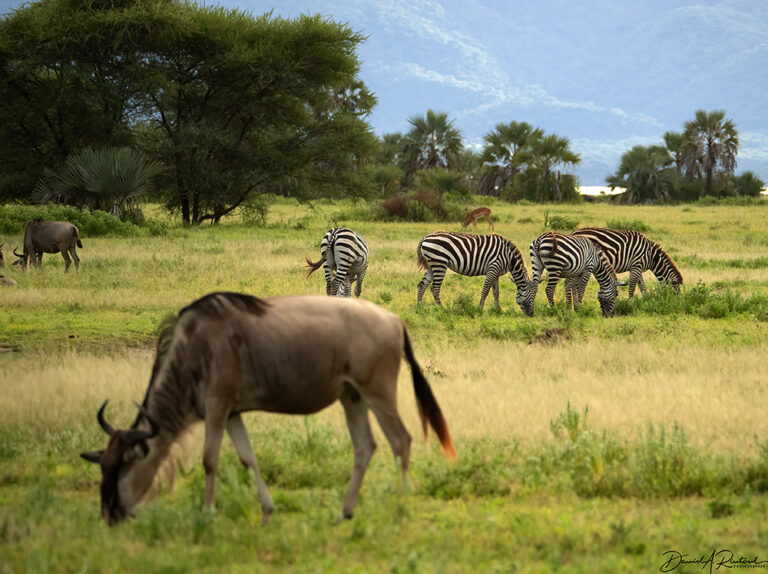
On our way to the park that morning, after a lovely overnight stay at the nearby Burunge Tented Lodge (check out that swimming pool!), we watched zebras and wildebeest grazing along the roadside. This was our first encounter with the two most numerous hoofed herbivores of the Serengeti ecosystem. You can also see a Thomson’s Gazelle (aka cheetah box lunch) grazing in the background here. Click here for larger image.
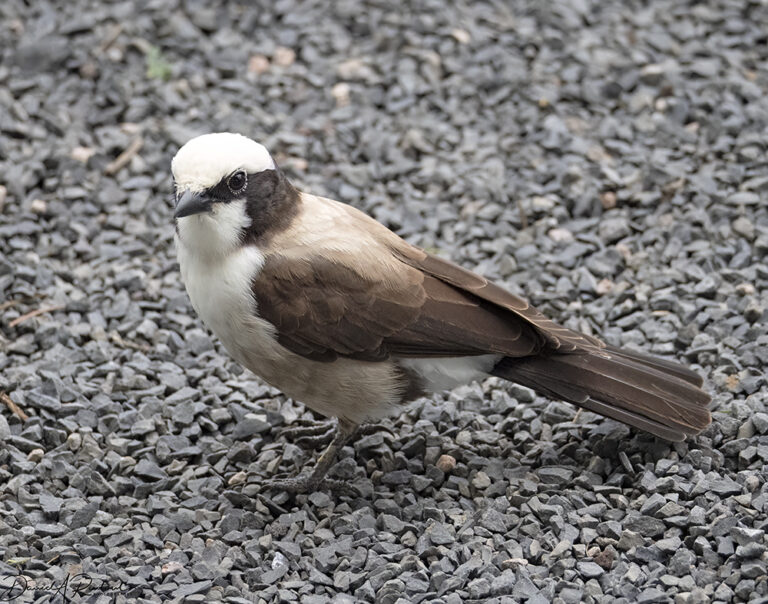
One of the major bird groups in this part of Africa is the shrike family, Laniidae. North American birders are familiar with the Loggerhead Shrike, and in some parts of the US we can see Northern Shrikes. Generally we don’t think of this as a very diverse family, but there are at least 15 species in east Africa. Here is a striking and fairly common shrike, White-rumped Shrike (Eurocephalus ruppelli, aka Northern White-crowned Shrike). It was foraging in a small parking area near the Tarangire park HQ. Click here for larger image.
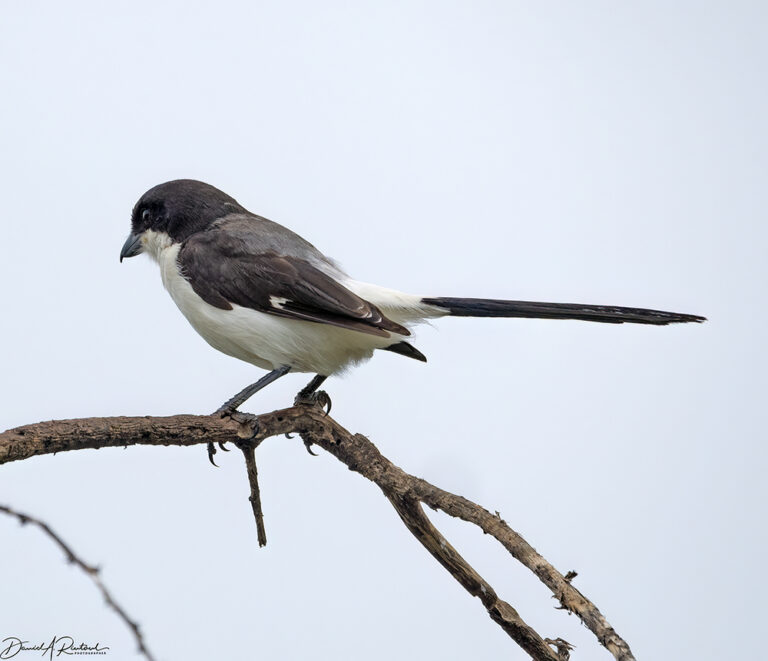
Here’s another striking shrike, the Long-tailed Fiscal (Lanius cabanisi). “Fiscal” is a name applied to several shrike species, and is allegedly derived from the resemblance of these birds to the suit-and-tie clad tax collectors, known as fiscals in southern Africa. It is a large bird, over a foot long from bill tip to tail tip! Click here for larger image.
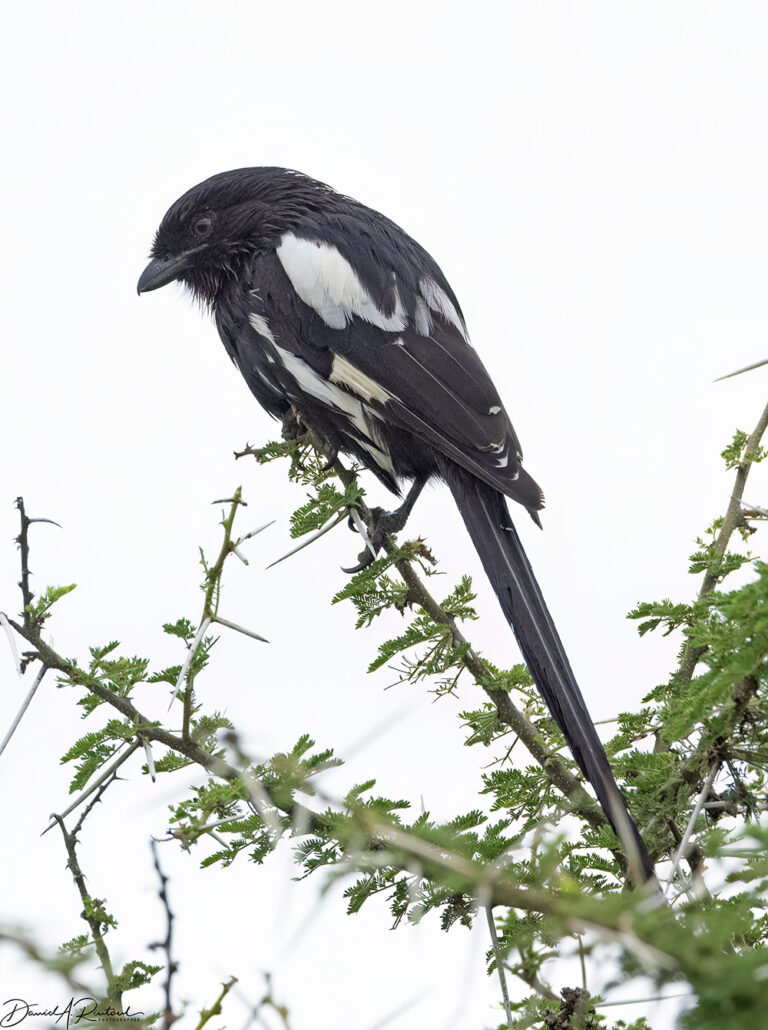
The final shrike species for today is the Magpie Shrike (Lanius melanoleucus). It is the largest of them all, reaching a length of 50 cm (20 inches in American). I wanted to get pictures of this species in flight, since its white rump patch forms a distinctive V-shape, but the birds that we saw were all content to just sit around and pose. Click here for larger image.

Double-lifer photograph! The top two birds are African Gray Hornbills (Lophoceros nasutus), and are males based on the mostly-black bill with the white patch. This is one of the smaller hornbill species, and ranges across most of sub-Saharan Africa. The gray and white bird at the bottom is a Bare-faced Go-away Bird (Corythaixoides personatus), a species that I have wanted to see since I first started learning about African birds. It is in the family Musophagidae, the turacos, which is one of two bird families endemic to Africa. They are very noisy birds, but I never heard one give the onomatopoetic “go away” call. Click here for larger image.
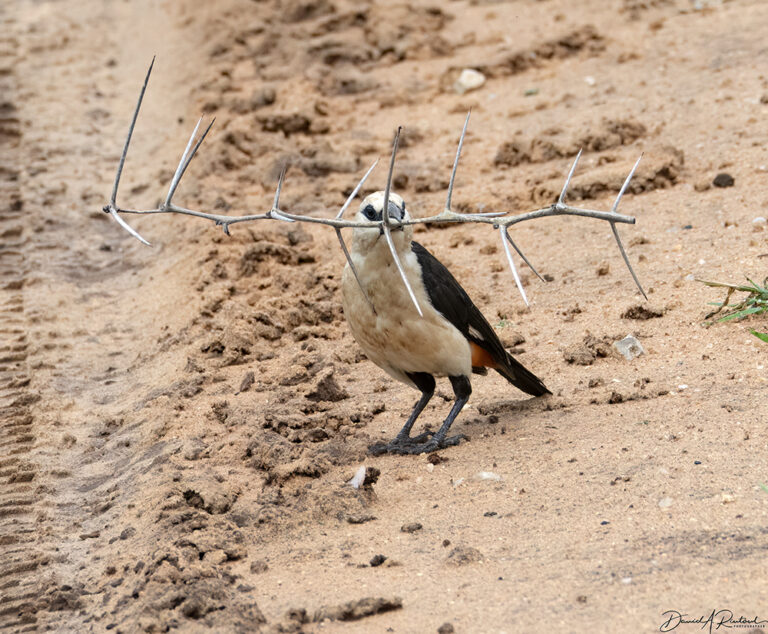
We first encountered the White-headed Buffalo-weaver (Dinemellia dinemelli) on our first day in the park, but we had several more on day 2. This one was very ambitious in its choice of a thorny acacia twig to use in constructing its nest! Click here for larger image.
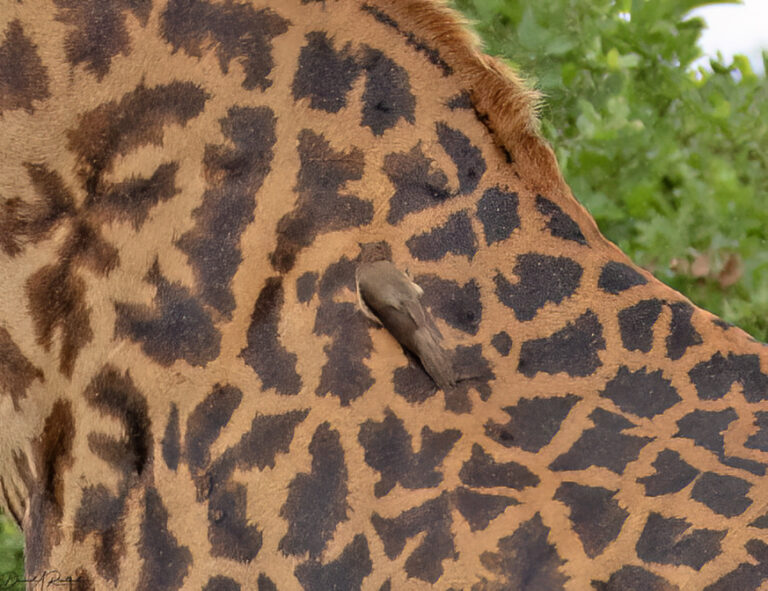
We also found many more giraffes and their attendant Red-billed Oxpeckers (Buphagus erythrorynchus) on day 2. I had not realized how neatly these guys can disappear into the blotchy background of a Maasai giraffe neck. Click here for larger image.
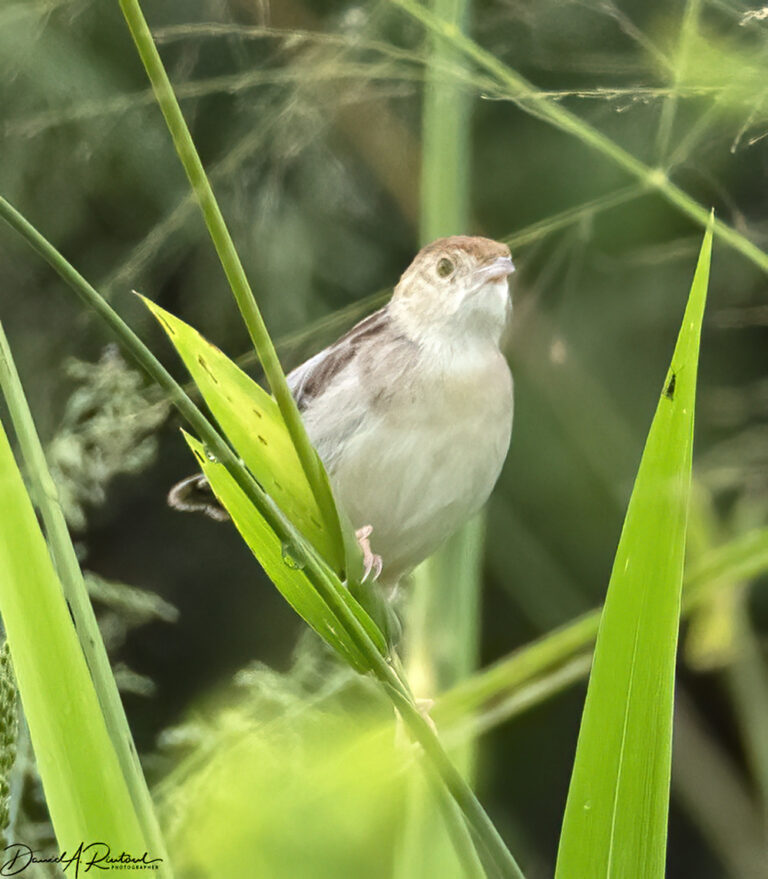
One of the largest bird families in this region is the cisticolas (pronounced sis-TIC-olas, in case you were interested. There are over 50 species in the genus Cisticola; all but two of them are found in Africa. Many of them have adjectival names corresponding to the sounds they make (e.g.Tinkling, Churring, Rattling, Wailing, Croaking, etc.). Almost all of them are small, skulking, and dully-plumaged. This is the Rattling Cisticola (Cisticola chiniana), To add to this complexity, there are also about 17 recognized subspecies of the Rattling Cisticola, including one with the scientific name C. c. fricki. If there is really a god, that subspecies will soon be elevated to species level and named the Fricking Cisticola. Click here for larger image.
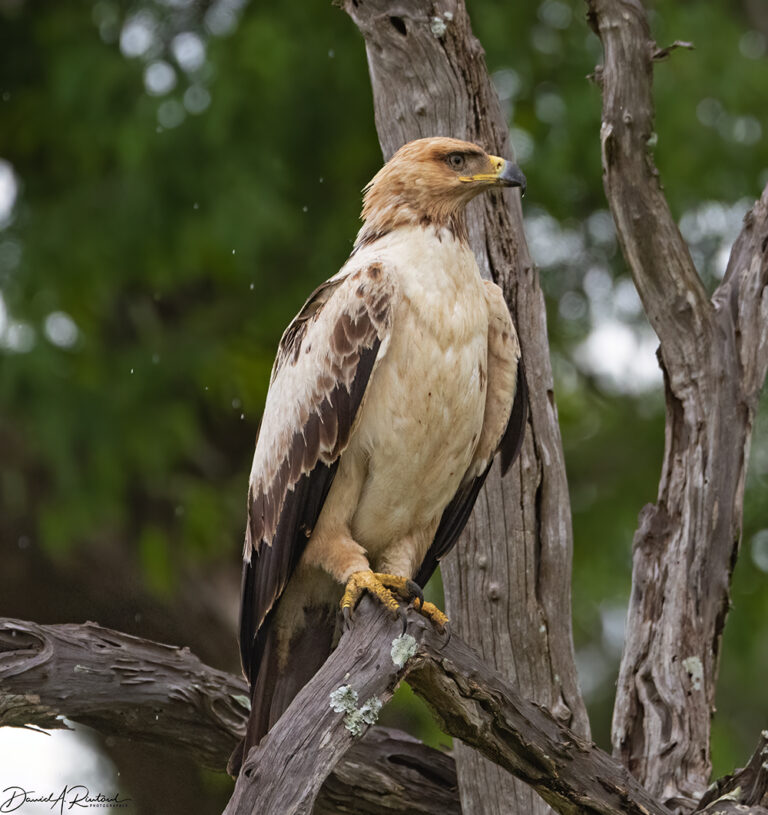
Contrary to the situation with the cisticolas, which are small, shy, local, and hard to see, this species, the Tawny Eagle (Aquila rapax) is widespread, abundant, and likes to perch in high visible spots. It was commonly seen in the parts of Tanzania where we traveled, but its populations are considered to be vulnerable in other parts of its range. Like many Old World “eagles”, it is somewhat larger than our familiar Red-tailed Hawks (Buteo jamaicensis) of North America, but somewhat smaller than the largest North American Hawk, the Ferruginous Hawk (B.regalis). Click here for larger image.
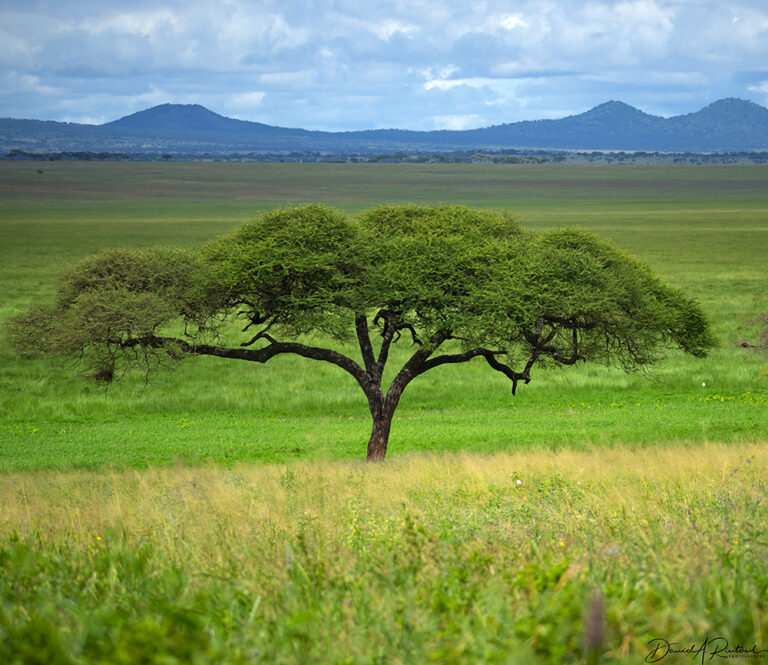
This is a view of another unique ecosystem, the Silale Swamps. This wetland of 70 square kilometers is green and lush nearly year-round. In the dry season it attracts elephants and many other grazers, which in turn attract predators like lions, leopards and African Wild Dogs. This is the view from our picnic lunch spot on the edge of the wetland. Click here for larger image.

eclare
Love the swamp photo.
Van Buren
Love the giraffe photo, and if you asked me to close my eyes and picture East Africa, the swamp photo is about what I’d see.
currants
@albatrossity: “Drinking from a fire hose is the best analogy/cliché that I can think of to describe this feeling.” That is a PERFECT description. I remember waking up the first morning in Kenya (we had arrived not late, but after dark), looking around, and realizing NOTHING–not grasses, not trees, not flowers, not birds–was familiar. Although I was already 45, it was the first time I realized how well and carefully I knew my environment, and that made the first few days utterly exhausting. But what an exhilarating environment!
stinger
Wow. I’m no birder, but every photo makes me exclaim aloud. It must have felt really good to get that double-lifer shot.
The White-headed Buffalo-weaver appears to be red-rumped — I’m surprised that’s not part of its name!
The Red-billed Oxpecker is hiding in plain sight. I love the pearly breast of the Rattling Cisticola, and the color of the Tawny Eagle’s head. The latter bird seems to be draped in a dark-edged cloak, very striking.
Closer to home, I’m happy to say that I’ve just received the 2023 David Rintoul calendar, Birds of Flyover Country. Its images more nearly correspond to what I see outside my window!
mvr
I too liked the wetland photo. It seemed rather calming.
Do the shrikes in Tanzania behave like the shrikes in North America, by which I mean eat small prey and impale them on the ends of bushes and such?
Thanks!
JanieM
Bare-faced Go-away Bird is my new favorite bird name ever, but Fricking Cisticola would be right up there.
The two landscapes are beautiful, the swamp one rather haunting. And it’s easy to feel your delight in the chance to drink from a firehose. Thanks for taking us along.
Betty
@mvr: Maybe that is who the Buffalo weaver had in mind with his choice of nesting material. ” Come after my babies, and I’ll stick you.”
Albatrossity
@mvr:
I don’t know! I didn’t notice any such larders, but there are certainly plenty of thorns for them to use if they did that!
pieceofpeace
Thanks as always for bringing into view the richness of the world. I hope I get to Africa some day and enjoy a good deal of life there which your images convey, so well.
BigJimSlade
“This one was very ambitious in its choice of a thorny acacia twig to use in constructing its nest!”
Cozy!
mvr
@Betty:
:-)
mvr
@Albatrossity: If you don’t know who does?
Having written that I decided that Google might. I found this article
which seems to indicate that at least some do, though it mostly focused on the impaling of dates.
Albatrossity
@mvr:
I think all of of have had dates like that :-)